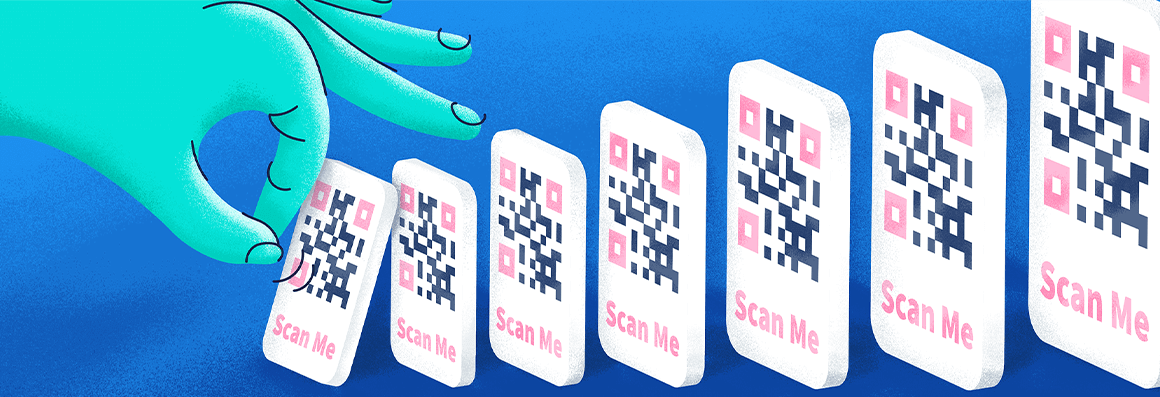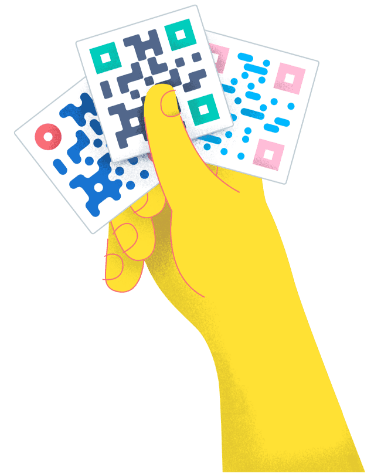- Best Practices ●
- COVID-19 ●
- Industry Trends ●
- Partners ●
- Product ●
How To Create Your Own QR Code Landing Page: 10 Tips To Know
Businesses across the globe use landing pages to generate new customers. They’re a key part of digital marketing, as they’re designed to persuade visitors to take specific actions, like filling out lead forms.
While landing page design involves more or less the same elements, each page should contain a certain uniqueness for the specific product or service sold. An inventive way to make your landing pages stand out and improve traffic is with QR Codes. With QR Code marketing on the rise because of its exceptional results, it’d be a mistake to let the chance to create QR Code landing pages pass you by.
How do you create a custom landing page? Keep on reading!
What is a landing page?
“Landing page” has become a buzzword across the business and marketing world due to its usefulness. A landing page is a web page designed to generate leads and drive sales. It’s where visitors “land” after clicking on ads to either learn more about your business or make purchases.
A landing page isn’t to be confused with a homepage. While both can drive sales, landing pages are usually more dedicated to customer conversion. As such, their single most important element is the call to action (CTA).
Usually, there are two types of landing pages: lead generation and clickthrough. Lead generation landing pages focus on collecting visitor information for lead purposes, while click-through landing pages focus on getting customers to make purchases immediately.
Users may be brought to landing pages through the following methods:
- Google ads
- Social media (ads and post content)
- Email marketing
- SEO (search engine optimization)
- QR Codes
With QR Codes, visitors are directed to your page after scanning your codes. A QR Code landing page is an excellent option if your campaign includes offline marketing materials. Think of it as a bridge between offline marketing mediums and desired actions, like newsletter signups or product purchases.
Benefits of designing a high-quality QR Code landing page
Is creating a custom QR Code landing page worthwhile? The answer is a resounding yes! Here are some benefits:
- Provide a seamless transition from QR Code scans to valuable information.
- Enhance visitor engagement.
- Create a positive brand impression.
- Gain insights into the effectiveness of your campaign through QR Code analytics.
- Collect valuable visitor data for future communications.
- Improve conversion rates.
10 tips for creating a custom QR Code landing page
You can only enjoy the benefits mentioned above if you make a high-quality custom landing page. As you’ll see below, there are certain elements you need to incorporate into your landing page to evoke desired actions.
Luckily, QR Code technology has developed to work together with typical landing page design elements, so you should have an easy time generating QR Codes after creating your landing pages. Here’s how to create a custom QR Code landing page:
1. Write a compelling CTA
A CTA is a core element because it pinpoints the goal that the landing page was developed around. Create clickable and captivating CTAs to increase the likelihood of achieving desired results.
There are various ways to make your CTA captivating. One of the most common ones is to include an incentive for visitors to click. For example, you can use “Sign up for a Free Trial” as your CTA to encourage new customers to sign up for your service. You can also use colors like green, red, orange, yellow, and blue for your CTA buttons. When used in marketing, such colors can impact consumer behavior.
Other tips to help you create a compelling CTA include:
- Ensure your CTA aligns with your landing page’s intent. For example, if you make a landing page to encourage your target audience to listen to your podcast, use a CTA like “Play MP3.”
- Keep your CTAs short, preferably five to seven words.
- Use a CTA with an active verb.
- Place the CTA in a clear and easily findable area on the page. Depending on the page length, you can position it in one or multiple places—the latter is ideal for long landing pages. Alternatively, you can use a floating or popup CTA button that remains visible even when visitors scroll through your page.
QR Codes on landing pages should have a clear CTA
2. Write clear, transparent headings
The heading is the first thing visitors see when they open a QR Code landing page. Use it to improve your chances of driving conversions.
How do you do so? By keeping things simple. Be clear and transparent, telling visitors exactly what to expect from your landing page. The landing page’s content and heading must match to avoid confusion.
You can also improve conversion rates by promising a benefit in the heading. For example, a heading like “Say Hello to a Pain-Free Life” can suit pain management experts. Promising a benefit encourages visitors to scroll through your page.
3. Style your brand’s copy
“Copy” is all the text that’s written on the landing page. It should reflect your brand’s style and tone.
Remember, landing pages are different from regular web pages. Their goal is to get visitors to take specific actions. As such, keep your landing page copy short and snappy. The point here is not to inform your readers in-depth but to get them to take a particular step, bringing them further into the sales process.
4. Focus on high-quality branding
Images capture visitors’ attention and interest while on your page. They also help convey additional information, making them necessary additions to your web page.
Use high-quality images that are purposeful in that they support the copy and the general tone you’re using. The images used on a landing page should reflect the quality of your brand and help customers associate a specific message with your business.
It’s also important to display your logo at least once to ensure visitors know they’re on your page. Consider branding QR Codes as well by adding your business logo. This creates consistency between your landing page and QR Codes.
QR Code Generator makes it simple to customize every aspect of your QR Code. You can add custom frames, use your brand colors, and put your logo in the middle of your QR Codes, allowing you to maintain consistency in your brand image.
Example of customization options from QR Code Generator software
5. Don’t forget social links
Landing pages often get a lot of traffic. You can kill two birds with one stone by adding social links to drive visitors to your social media pages and amplify engagement. To avoid cluttering your landing page, only include social links to platforms that are popular with your target audience.
For example, Instagram and TikTok are great options for brands that target Gen Z consumers, as these are among their most commonly used apps.
If you want to increase social media engagement for your business, you can bypass creating a website URL and take visitors directly to the target social media platform. There is a QR Code for precisely this purpose: Social Media QR Codes.
You can use QR Codes to direct your target audience to Facebook, X, LinkedIn, Snapchat, and more. The best part is that the content encoded in your QR Code adapts to different devices, including desktops, tablets, and Android and iOS mobile devices, so you get to engage a broad audience.
An example of a custom Social Media QR Code
6. Try QR Codes instead of forms
Many landing pages use a form to encourage users to input their personal data for future communication. As mentioned, this is a common form of lead generation because it gives marketers insight into which audiences are interested in their products and services. It’s also one of the most common methods for growing email marketing lists.
But, forms are limited in space and scope. You can’t make them too long, as this can affect your lead generation efforts. Sometimes, even having a form in the first place can be a deterrent.
Create QR Codes instead of limiting yourself to landing page forms. If you have a QR Code, customers only need to scan it to take your desired action. You can link your Code to quick-contact forms to collect customers’ email addresses or phone numbers, social media pages to drive social engagement, and many more instantaneously—the use cases are endless!
And the best part is that you can incorporate QR Codes anywhere from digital ads to physical marketing materials, like flyers. For a high-quality QR Code, visit QR Code Generator, choose the type of QR Code you want to create, fill in the required fields, and download the code in jpg or png format. We recommend these formats because they’re scannable, even on digital screens.
7. Track your performance
How do you know if you have an effective CTA, a powerful headline, or compelling content? Simple: by tracking your performance.
Conduct A/B testing to identify the best version of your landing page. To do so, make minor tweaks to your current landing page and observe how metrics like the number of page visits and contacts gained change. You can start with something as small as changing your headline, then your CTA placement and web copy to find the most effective landing page version.
For convenience, consider using landing page builders. These tools can easily create different versions of your landing page, allowing you to conveniently test the variables mentioned above. Choose a builder that allows integrations with other marketing tools for efficient A/B testing.
QR Codes can provide valuable assessment insights. All Dynamic QR Codes made with QR Code Generator software reveal helpful tracking information: location by city and country, operating device used, time scanned, and total vs. unique scans. This allows you to compare campaigns over different periods and locations and improve future marketing campaigns.
Demo version of QR Code tracking metrics available with QR Code Generator software
8. Optimize for desktop and mobile
Optimize your landing page for display on all devices to expand your reach and avoid losing potential customers. Your landing page should load quickly and look great on all devices for high conversion rates. To determine if this is the case for your web page, test it before creating your QR Code.
An example of an App QR Code on a landing page
9. Keep your content short
Landing pages are typically shorter forms of web pages because the goal is to convert the customer by providing a summary of a product or service. The copy and the page should be short and to the point. So, read through your content and eliminate non-essential information before creating your QR Code landing page.
10. Employ a simple design with engaging visuals
Visuals can stir engagement in ways text alone can’t, making them vital additions to your landing page. Use high-quality images and videos to convey a professional brand image. For the best results, work with a professional photographer.
Ensure your visuals are relevant to your landing page’s content. You can showcase your product, people using it, or some of its benefits. To appear professional, aim for a clean, simple design—don’t use too many visuals, as they can make your page appear cluttered and distract visitors from your content and CTA.
Enhance your digital strategy with custom QR Code landing pages
Custom QR Code landing pages can enhance your digital marketing strategy by increasing leads and conversion rates. The quality of your landing page will determine the results you achieve. The better your page, the better the results will be.
With QR Code Generator, you can quickly generate QR Codes for your landing pages and improve your marketing campaigns—all you need is a landing page URL. Implement the tips we’ve discussed here to create your landing page and use the tool to make it easy for your target audience to access your web page from different marketing mediums.
Sign up now to create QR Codes and improve lead generation and sales conversion efforts!





